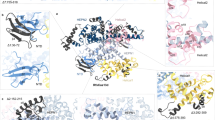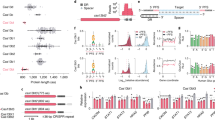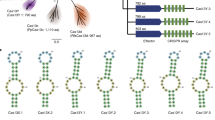Abstract
Clustered regularly interspaced short palindromic repeats–Cas13 effectors are used for RNA editing but the adeno-associated virus (AAV) packaging limitations because of their big sizes hinder their therapeutic application. Here we report the identification of the Cas13j family, with LepCas13j (529 aa) and ChiCas13j (424 aa) being the smallest and most highly efficient variants for RNA interference. The miniaturized Cas13j proteins enable the development of compact RNA base editors. Chi-RESCUE-S, by fusing dChiCas13j with hADAR2dd, demonstrates high efficiency and specificity in A-to-G and C-to-U conversions. Importantly, this system is compatible with single-AAV packaging without the need for protein sequence truncation. It successfully corrected pathogenic mutations, such as APOC3D65N and SCN9AR896Q, to the wild-type forms. In addition, we developed an optimized system, Chi-RESCUE-S-mini3, which pioneered efficient in vivo C-to-U RNA editing of PCSK9 in mice through single-AAV delivery, resulting in reduced total cholesterol levels. These results highlight the potential of Cas13j to treat human diseases.

This is a preview of subscription content, access via your institution
Access options
Access Nature and 54 other Nature Portfolio journals
Get Nature+, our best-value online-access subscription
$32.99 / 30 days
cancel any time
Subscribe to this journal
Receive 12 print issues and online access
$259.00 per year
only $21.58 per issue
Buy this article
- Purchase on SpringerLink
- Instant access to full article PDF
Prices may be subject to local taxes which are calculated during checkout






Similar content being viewed by others
Data availability
The RNA-seq data for the detection of DRGs following Cas13j-mediated endogenous mRNA cleavage and off-target SNVs of RNA base editors were deposited to the NCBI Sequence Read Archive under accession code PRJNA971358. The hg38 reference genome (Homo sapiens genome assembly GRCh38.p14, NCBI, National Library of Medicine (https://www.nih.gov/)) was used for alignment in the analysis of RNA-seq data from HEK293T cells. The ClinVar database (https://www.nih.gov/) was used to identify pathogenic SNVs that could be corrected by cytosine base editing of RESUCE-S. There are no restrictions on data availability. Source data are provided with this paper.
References
van Houte, S. et al. The diversity-generating benefits of a prokaryotic adaptive immune system. Nature 532, 385–388 (2016).
Abudayyeh, O. O. et al. C2c2 is a single-component programmable RNA-guided RNA-targeting CRISPR effector. Science 353, aaf5573 (2016).
Shmakov, S. et al. Diversity and evolution of class 2 CRISPR–Cas systems. Nat. Rev. Microbiol. 15, 169–182 (2017).
Makarova, K. S. et al. Evolutionary classification of CRISPR–Cas systems: a burst of class 2 and derived variants. Nat. Rev. Microbiol. 18, 67–83 (2020).
Liu, L. et al. The molecular architecture for RNA-guided RNA cleavage by Cas13a. Cell 170, 714–726 (2017).
Myhrvold, C. et al. Field-deployable viral diagnostics using CRISPR–Cas13. Science 360, 444–448 (2018).
Abudayyeh, O. O. et al. RNA targeting with CRISPR–Cas13. Nature 550, 280–284 (2017).
Konermann, S. et al. Transcriptome engineering with RNA-targeting type VI-D CRISPR effectors. Cell 173, 665–676 (2018).
Nakagawa, R. et al. Structure and engineering of the minimal type VI CRISPR–Cas13bt3. Mol. Cell 82, 3178–3192 (2022).
Kannan, S. et al. Compact RNA editors with small Cas13 proteins. Nat. Biotechnol. 40, 194–197 (2022).
Xu, C. et al. Programmable RNA editing with compact CRISPR–Cas13 systems from uncultivated microbes. Nat. Methods 18, 499–506 (2021).
Hu, Y. et al. Metagenomic discovery of novel CRISPR–Cas13 systems. Cell Discov. 8, 107 (2022).
Gootenberg, J. S. et al. Nucleic acid detection with CRISPR–Cas13a/C2c2. Science 356, 438–442 (2017).
Fozouni, P. et al. Amplification-free detection of SARS-CoV-2 with CRISPR–Cas13a and mobile phone microscopy. Cell 184, 323–333 (2021).
Yang, L. Z. et al. CRISPR-mediated live imaging of genome editing and transcription. Science 365, 1301–1305 (2019).
Cox, D. B. T. et al. RNA editing with CRISPR–Cas13. Science 358, 1019–1027 (2017).
Abudayyeh, O. O. et al. A cytosine deaminase for programmable single-base RNA editing. Science 365, 382–386 (2019).
Liu, Y. et al. REPAIRx, a specific yet highly efficient programmable A>I RNA base editor. EMBO J. 39, e104748 (2020).
Li, G. et al. Developing PspCas13b-based enhanced RESCUE system, eRESCUE, with efficient RNA base editing. Cell Commun. Signal. 19, 84 (2021).
Wilson, C. et al. Programmable m6A modification of cellular RNAs with a Cas13-directed methyltransferase. Nat. Biotechnol. 38, 1431–1440 (2020).
Powell, J. E. et al. Targeted gene silencing in the nervous system with CRISPR–Cas13. Sci. Adv. 8, eabk2485 (2020).
Xiao, Q. et al. Rescue of autosomal dominant hearing loss by in vivo delivery of mini dCas13X-derived RNA base editor. Sci. Transl. Med. 14, eabn0449 (2020).
Morelli, K. H. et al. An RNA-targeting CRISPR–Cas13d system alleviates disease-related phenotypes in Huntington’s disease models. Nat. Neurosci. 26, 27–38 (2023).
Zheng, Z. et al. Preventing autosomal-dominant hearing loss in Bth mice with CRISPR/CasRx-based RNA editing. Signal Transduct. Target Ther. 7, 79 (2022).
Balakrishnan, B. & Jayandharan, G. R. Basic biology of adeno-associated virus (AAV) vectors used in gene therapy. Curr. Gene Ther. 14, 86–100 (2014).
Daya, S. & Berns, K. I. Gene therapy using adeno-associated virus vectors. Clin. Microbiol Rev. 21, 583–593 (2008).
Mingozzi, F. & High, K. A. Therapeutic in vivo gene transfer for genetic disease using AAV: progress and challenges. Nat. Rev. Genet. 12, 341–355 (2011).
Doron, S. et al. Systematic discovery of antiphage defense systems in the microbial pangenome. Science 359, eaar4120 (2018).
Gao, L. et al. Diverse enzymatic activities mediate antiviral immunity in prokaryotes. Science 369, 1077–1084 (2020).
Makarova, K. S. et al. An updated evolutionary classification of CRISPR–Cas systems. Nat. Rev. Microbiol. 13, 722–736 (2015).
Ge, X. et al. AtNUDT7, a negative regulator of basal immunity in Arabidopsis, modulates two distinct defense response pathways and is involved in maintaining redox homeostasis. Plant Physiol. 145, 204–215 (2007).
Landrum, M. J. et al. ClinVar: improvements to accessing data. Nucleic Acids Res. 48, D835–D844 (2020).
Landrum, M. J. et al. ClinVar: public archive of interpretations of clinically relevant variants. Nucleic Acids Res. 44, D862–D868 (2016).
Landrum, M. J. et al. ClinVar: public archive of relationships among sequence variation and human phenotype. Nucleic Acids Res. 42, D980–D985 (2014).
Li, G. et al. A novel base editor SpRY-ABE8eF148A mediates efficient A-to-G base editing with a reduced off-target effect. Mol. Ther. Nucleic Acids 31, 78–87 (2022).
Rothgangl, T. et al. In vivo adenine base editing of PCSK9 in macaques reduces LDL cholesterol levels. Nat. Biotechnol. 39, 949–957 (2021).
Zhang, D. et al. Binding of proprotein convertase subtilisin/kexin type 9 to epidermal growth factor-like repeat A of low density lipoprotein receptor decreases receptor recycling and increases degradation. J Biol. Chem. 282, 18602–18612 (2007).
Tardif, J. C. et al. Apolipoprotein C-III reduction in subjects with moderate hypertriglyceridaemia and at high cardiovascular risk. Eur. Heart J. 43, 1401–1412 (2022).
Duan, G. et al. A single-nucleotide polymorphism in SCN9A may decrease postoperative pain sensitivity in the general population. Anesthesiology 118, 436–442 (2013).
Hyatt, D. et al. Prodigal: prokaryotic gene recognition and translation initiation site identification. BMC Bioinformatics 11, 119 (2010).
Fu, L. et al. CD-HIT: accelerated for clustering the next-generation sequencing data. Bioinformatics 28, 3150–3152 (2012).
Acknowledgements
This work was partially supported by grants from the National Key R&D Program of China (2023YFC3402402 to Y. Yao), National Natural Science Foundation of China Major Project Topic (42090060 to B.M.), National Natural Science Foundation of China General Program (32071347 to Y. Yao), Key International Joint Research Program of the National Natural Science Foundation of China (31920103005 to X.-x.C.), Zhejiang Lab Open Research Project as joint China Computer Federation–Zhejiang Lab Research Project (K2022PE0AB08 to Y. Yao), ZJU-Hangzhou Global Scientific and Technological Innovation Center, Zhejiang University (02020200-K02013008 to Y. Yao) and Jiangsu Wuzhong Aesthetics Biotech Co., Ltd (XS-KF-2022-0098 to Y. Yao). We express our gratitude to X. Shen for his insights on evolution and acknowledge the support of the ZJU-Hangzhou Global Scientific and Technological Innovation Center, Zhejiang University, the iBiofoundary and the Core Facility of the Institute for Intelligent Bio/Chem Manufacturing.
Author information
Authors and Affiliations
Contributions
Y. Yao directed the research. Y. Yao and G.L. conceptualized the project and designed the study. B.M. contributed the soil metagenome dataset. J.Y. conducted the bioinformatics analysis of the soil metagenomes. Experiments were designed by Y. Yao and G.L., who also wrote the paper. G.L., with the assistance of Y.C., conducted the experiments. Y.Z. and X. Hu analyzed the RNA-seq data. H.M. and Y.Z. performed the analysis of the HEPN motif in Cas13 proteins. X.-x.C. performed the evolutionary analysis. X.-x.C., Q.J. and X. Huang contributed to the discussion of the paper. Protein structure modeling was undertaken by Z.P. G.Z., Y. Yuan, Z.Z., X.Z., J.Q. and K.T. provided technical support. Y. Yao, X. Huang and X.-x.C. supervised the project. Y. Yao acquired the funding for this study. Y. Yao is the lead contact corresponding author.
Corresponding authors
Ethics declarations
Competing interests
Patent applications (application numbers CN 202311234142.X and CN 202311337233.6) based on the Cas13j and variants on RNA editing have been submitted but not yet authorized. The patent applicant is ZJU-Hangzhou Global Scientific and Technological Innovation Center, Zhejiang University and Y. Yao, G.L., B.M., J.Y. and Y.C. are listed as inventors. The other authors declare no competing interests.
Peer review
Peer review information
Nature Chemical Biology thanks Osamu Nureki and the other, anonymous reviewer(s) for their contribution to the peer review of this work.
Additional information
Publisher’s note Springer Nature remains neutral with regard to jurisdictional claims in published maps and institutional affiliations.
Extended data
Extended Data Fig. 1 PFS analysis of Cas13j proteins mediated mRNA knockdown.
a. The PFS analysis of LepCas13j in three types of mCherry reporters. b. The PFS analysis of ChiCas13j in three types of mCherry reporters. All values shown are mean ± s.e.m. (n = 3 biological replicates, each average of 3 technical replicates).
Extended Data Fig. 2 Collateral activity comparison of Cas13j proteins in HEK293T cells.
a. Schematics describing collateral activity detection system based on eGFP-transgenic HEK293T cells. b. Target knockdown and collateral activity for ChiCas13j targeting 16 mCherry reporters. c. Target knockdown and collateral activity for LepCas13j targeting 16 mCherry reporters. d. Target knockdown and collateral activity for ChiCas13j and LepCas13j targeting KRAS, RAF1, and NF2 endogenous mRNA. e. GFP MFI detection of ChiCas13j and LepCas13j targeting KRAS, RAF1, and NF2 endogenous mRNA. All values shown are mean ± s.e.m. (n = 3 biological replicates, each average of 3 technical replicates).
Extended Data Fig. 3 Down-regulated genes analysis of RNA-seq for Cas13j targeting endogenous mRNA.
a. Down-regulated genes analysis of RNA-seq for ChiCas13j knockdown endogenous transcripts. DRGs, down-regulated genes, compared with WT control cells. b. Down-regulated genes analysis of RNA-seq for LepCas13j knockdown endogenous mRNA. DRGs, down-regulated genes, compared with WT control cells. All values shown are mean ± s.e.m. (n = 3).
Extended Data Fig. 4 Mismatch position tiling to find optimal editing guide design for dCas13j-REPAIRv2 and dCas13j-RESCUE-S RNA base editors.
a. GFP percentage of editing mCherry-STOP-eGFP reporter with varying base motifs with dCas13j-REPAIRv2 and guides with mismatches at position 18, 20, 22, 24, 26, and 28. b. GFP percentage of editing mCherry-BFP reporter with varying base motifs with dCas13j-RESCUE-S and guides with mismatches at position 18, 20, 22, 24, 26, and 28. All values shown are mean ± s.e.m. (n = 3 biological replicates, each average of 3 technical replicates).
Extended Data Fig. 5 Chi-REPAIRv2-mini and Chi-RESCUE-S-mini for efficient RNA base editing.
a. The schematic of three truncated ChiCas13j proteins. b. The mRNA cleavage efficacy of truncated ChiCas13j was analyzed by reporter assay. Statistical significance was assessed using two-tailed t-tests. p < 0.05 was considered to be statistically significant. c. The schematic of Chi-REPAIRv2-mini and Chi-RESCUE-S-mini RNA base editors by fusing truncated dChiCas13j with ADAR2dd variants. d. A-to-G editing efficiency of Chi-REPAIRv2-mini and REPAIRv2 on endogenous transcripts in HEK293T cells. e. A-to-G editing efficiency of Chi-RESCUE-S-mini and RESCUE-S on endogenous transcripts in HEK293T cells. f. C-to-U editing efficiency of Chi-RESCUE-S-mini and RESCUE-S on endogenous transcripts in HEK293T cells. All values shown are mean ± s.e.m. (n = 3 biological replicates, each average of 3 technical replicates).
Extended Data Fig. 6 Comparison of editing efficiency between Chi-REPAIRv2-mini and REPAIRv2, Chi-RESCUE-S-mini and RESCUE-S.
a. A-to-G editing efficiency of 20 endogenous sites mediated by REPAIRv2, Chi-REPAIRv2-mini1, Chi-REPAIRv2-mini2 and Chi-REPAIRv2-mini3 in HEK293T cells. b. A-to-G editing efficiency of 20 endogenous sites mediated by RESCUE-S, Chi-RESCUE-S-mini1, Chi-RESCUE-S-mini2 and Chi-RESCUE-S-mini3 in HEK293T cells. p < 0.05 was considered to be statistically significant. c. C-to-U editing efficiency of 20 endogenous sites mediated by RESCUE-S, Chi-RESCUE-S-mini1, Chi-RESCUE-S-mini2 and Chi-RESCUE-S-mini3 in HEK293T cells. p < 0.05 was considered to be statistically significant. All values shown are mean ± s.e.m. (n = 20). Statistical significance was assessed using two-tailed t-tests compared to REPAIRv2 or RESCUE-S.
Extended Data Fig. 7 All-in-one constructs of mini RESCUE-S mediated endogenous mRNA base editing.
a. A-to-G editing efficiency among RESCUE-S, Chi-RESCUE-S, Chi-RESCUE-S-mini3, RESCUE-S-X.1 and RESCUE-S-t1. p < 0.05 was considered to be statistically significant. b. C-to-U editing efficiency among RESCUE-S, Chi-RESCUE-S, Chi-RESCUE-S-mini3, RESCUE-S-X.1 and RESCUE-S-t1. p < 0.05 was considered to be statistically significant. All values shown are mean ± s.e.m. (left n = 3 biological replicates, each average of 3 technical replicates, right n = 20). Statistical significance was assessed using two-tailed t-tests compared to RESCUE-S.
Extended Data Fig. 8 Representative immunofluorescence staining of HEK293T cell models transduced with AAV9 encoding Chi-RESCUE-S.
Scale bar=100 μm.
Extended Data Fig. 9 Efficient sgRNA screening of PCSK9 (Q35*) site C-to-U base editing.
All values shown are mean ± s.e.m (n = 3 biological replicates, each average of 3 technical replicates).
Extended Data Fig. 10 In vivo PCSK9 (Q35*) C-to-U RNA base editing by mini RESCUE-S reduced T-CHO levels in mice plasma samples.
a. RNA base editor expression in mouse liver samples, n = 5. b. T-CHO levels in plasma samples of mini RESUCE-S expression mice. p < 0.05 was considered to be statistically significant. c. LDL-C levels in plasma samples of mini RESUCE-S expression mice. p < 0.05 was considered to be statistically significant. All values shown are mean ± s.e.m. (n = 5 biological replicates). Statistical significance was assessed using two-tailed t-tests compared to WT group. WT, wide type.
Supplementary information
Supplementary Information
Supplementary Figs. 1–12 and Tables 2 and 5–16.
Supplementary Tables 1, 3 and 4
Supplementary Table 1: The information of soil metagenomes used in this study. Supplementary Table 3: DRG analysis of RNA-seq for Cas13j targeting endogenous mRNA. Supplementary Table 4: The RxxxxH motif of Cas13 proteins. a, The N-RxxxxH motif and C-RxxxxH motif information of Cas13 proteins; b, The amino acid distribution of N-RxxxxH and C-RxxxxH motif among different Cas13 proteins.
Supplementary Data 1
Statistical source data for Supplementary Figs. 4 and 8–11. Unprocessed source fluorescence images for Supplementary Figs. 5 and 6.
Source data
Source Data Figs. 1–6 and Extended Data Figs. 1–7, 9 and 10
Statistical source data.
Source Data Fig. 6 and Extended Data Figs. 8 and 10
Uncropped gels and images.
Rights and permissions
Springer Nature or its licensor (e.g. a society or other partner) holds exclusive rights to this article under a publishing agreement with the author(s) or other rightsholder(s); author self-archiving of the accepted manuscript version of this article is solely governed by the terms of such publishing agreement and applicable law.
About this article
Cite this article
Li, G., Cheng, Y., Yu, J. et al. Compact RNA editors with natural miniature Cas13j nucleases. Nat Chem Biol 21, 280–290 (2025). https://doi.org/10.1038/s41589-024-01729-8
Received:
Accepted:
Published:
Issue date:
DOI: https://doi.org/10.1038/s41589-024-01729-8



